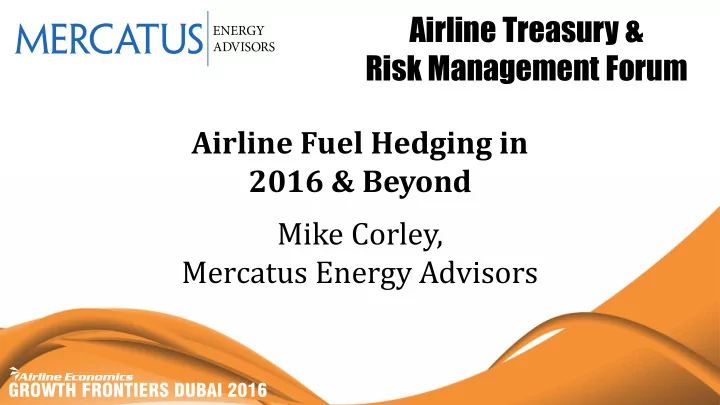

Airline Treasury & Risk Management Forum Airline Fuel Hedging in 2016 & Beyond Mike Corley, Mercatus Energy Advisors
The State of Airline Fuel Hedging in 2016 and Beyond 4 October 2016
How many aircraft are in your company’s fleet? 26% 37% 1-25 26-50 51-75 76-100 5% 100 or more 21% 11%
Company Ownership 21% 42% Publicly Traded Privately Held Government Owned 37%
Fuel as Percentage of Total Costs 21% 37% 1-25% 26-35% 36-45% 42%
Does your company hedge fuel price risk? 32% Yes No 68%
Does your company have a hedging/risk policy? 8% Yes No 92%
Primary purpose of your fuel hedging program? 60.0% 50.0% 40.0% 30.0% 20.0% 10.0% 0.0% Manage cash flow volatility Manage exposure to short-term fuel price increases Manage exposure to long-term fuel price increases Other
Who makes company’s fuel hedging decisions? 8% Board of Directors 23% Hedge or Risk Management Committee Chief Financial 8% Officer, VP of Finance, Treasurer Other 61%
What fuel hedging instruments does your company utilize? 80.0% 70.0% 60.0% 50.0% 40.0% 30.0% 20.0% 10.0% 0.0% Futures Forwards Swaps Call Collars Other (Physical) Options
What is the maximum tenor of your fuel hedge positions? 8% 15% 8% 1-6 Months 8% 7-12 Months 15% 13-18 Months 19-24 Months 25 Months or More Other 46%
% of fuel consumption hedged for coming 12 months 15% 8% 1-20% 46% 21-40% 41-60% 61-80% 31%
Primary reference index 23% Brent Crude Oil US Gulf Coast Jet Fuel 8% Rotterdam Jet Fuel (NW Europe and 69% ARA)
Anticipate credit related issues may limit your ability to hedge your fuel price risk in coming year? 25% Yes No 75%
Do you utilize clearing for credit risk management? 0% Yes No 100%
What type of firm is your primary counterparty(s) Global Financial Institution (i.e. BNP Paribas, Goldman Sachs, 8% Morgan Stanley, etc.) Local Financial 15% Institution (i.e. Abu Dhabi Commercial Bank, 42% DBS, National Bank of Canada, Nordea, etc.) Major Oil Company (i.e. Shell, BP, etc.) 23% Fuel Supplier (i.e. World Fuel Services) 12%
What is fuel hedging success to your company? When we minimize exposure to short- 8% 16% term fuel price increases. 17% When we minimize exposure to long- 17% term fuel price increases. When our cash flow volatility, as it relates to fuel 42% prices, is minimized.
How can company improve fuel hedging program? Strategies which better reflect the company’s risk tolerance and goals. 12% A policy which requires hedging on a consistent basis, regardless of our 35% opinion of the market. 17% A methodology which consistently seeks to optimize the company's existing hedge positions. A decision making framework based on 12% sound, quantitative analysis of relevant data? 12% Better execution and 12% implementation of existing hedging policy and strategies.
Does your company utilize hedge accounting treatment? 25% Yes No 75%
What system(s) do you use to manage fuel hedging? Spreadsheets (i.e. Microsoft Excel) 8% Treasury System (i.e. VisualRisk, 34% Sungard) Commodity Risk Management System 33% (i.e. Openlink) Financial Risk System (i.e. SuperDerivatives) 8% Enterprise Platform 17% (i.e. SAP)
Do you expect regulations (i.e. EMIR, Dodd Frank, Basel III) to impact your fuel hedging practices? 33% 42% Yes No Unsure 25%
What is your primary source of fuel market information? 15% Financial Institution (i.e. Goldman Sachs) Data Provider (i.e. Reuters) 85%
Most significant challenge regarding fuel hedging • Lack of access to credit lines • Large negative mark-to-market losses • Board of directors doesn’t understand pros and cons of hedging • Improve cost/benefit of fuel hedging • Weak balance sheet • Lack of internal knowledge and skills • Oil price volatility • Management makes decisions based on gut not information
Contact Mike Corley | Mercatus Energy Advisors +65.3158.2705 | corley@mercatusenergy.com
Contact Mike Corley | Mercatus Energy Advisors +65.3158.2705 | corley@mercatusenergy.com
Contact Mike Corley | Mercatus Energy Advisors +65.3158.2705 | corley@mercatusenergy.com
Recommend
More recommend